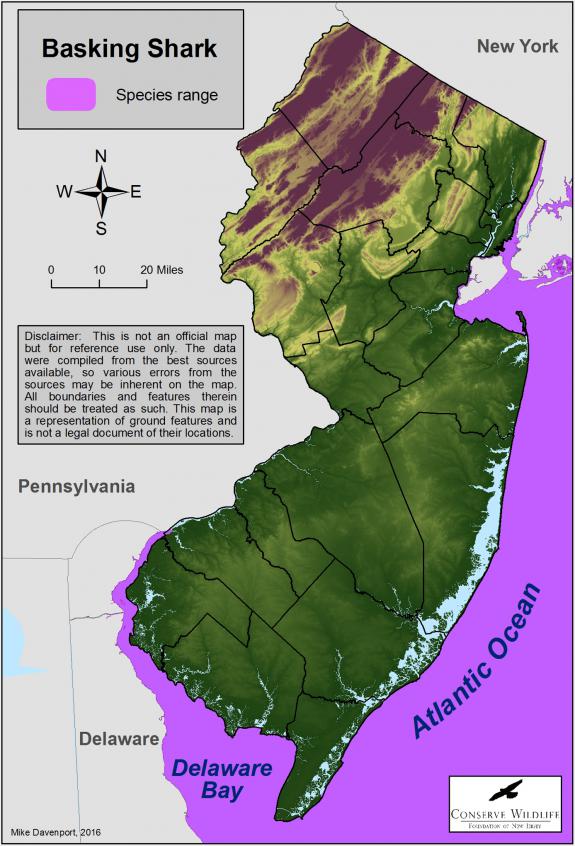Cetorhinus maximus
Type: fish
Status: not ranked
Species Guide
Basking shark
Cetorhinus maximus
Species Type: fish
Conservation Status: not ranked
IDENTIFICATION
Basking sharks are the second largest fish species after whale sharks. They can grow up to a length of 33 feet and a weight of up to 19 tons.
This species has an enormous mouth which is kept open while feeding, often at or near the water surface while swimming slowly (hence the name “basking”). The teeth are extremely small. They have small eyes, large gill slits that nearly encircle their head, a pointed snout, and are dark gray to brown in color. The first dorsal fin is large and the tail is crescent-shaped.

Distribution & Habitat
Basking sharks occur in cold and temperate waters of the Atlantic and Pacific Oceans. Within the northwest Atlantic Ocean, they can be found from Labrador, Canada in the north to Florida and the northern Gulf of Mexico in the south. They migrate seasonally between higher latitudes in the spring and summer and lower latitudes in the fall and winter.
This species is typically found within the ocean over the continental shelf and slope, but may winter in deeper offshore waters where they continue to feed on deep-water plankton. During the spring and summer, they are often observed feeding at or near the water’s surface, typically near oceanic fronts or convergence zones.
Diet
Basking sharks are filter-feeders feeding near the base of the food chain on zooplankton, especially on small crustaceans known as copepods. They have been observed feeding in large groups when ample food is available.
Despite their large size, this species is harmless to humans.
Life Cycle
In portions of its range, basking sharks show strong sexual segregation, with females far outnumbering males, or vice versa. Very little is known about their reproduction but it appears that their reproductive rate is very low. It is estimated that females may give birth somewhere between every 18 months to 3 years, with litter sizes of 1-6 young. Basking sharks are ovoviviparous. Age of sexual maturity and life span are unknown, though it is believed that they may live for at least several decades.
Despite their large size and slow swimming speed, basking sharks have been known to breach, jumping entirely out of the water, for reasons unknown. Their only known predator, aside from humans, are killer whales.
Current Threats, Status, and Conservation
The basking shark is considered a Species of Concern by the federal government within the eastern North Pacific Ocean (from Alaska to California). It currently has no federal status within the Atlantic Ocean nor does it have any New Jersey state conservation status. Though it has no legal conservation status in New Jersey, it is still illegal to take, possess, land, purchase, or sell them within the state.
The basking shark has been fished commercially as a source food, fins, and liver oil. Current populations appear to be very low, at a small fraction of what they had been historically. Reasons for the species decline include both commercial fishing and as by-catch. Its slow rate of reproduction further hampers its recovery.
Marine pollution, especially from plastics, threatens this and many other marine species and climate change may potentially harm this species by changing its prey abundance and distribution. Due to its habit of slowly swimming at the surface to feed, it is possible that collisions with watercraft may also take a toll on their populations.
This is a very poorly understood species and much about its behavior, seasonal movements, reproduction, and abundance is currently unknown.
References
- Compagno, Leonard, M. Dando and S. Fowler. 2005. Sharks of the World.
- NOAA National Marine Fisheries Service. Accessed June 16, 2016.
Text written by Michael J. Davenport in 2016.
Scientific Classification
- Kingdom: Animalia
- Phylum: Chordata
- Class: Chondrichthyes
- Order: Lamniformes
- Family: Cetorhinidae
- Genus: Cetorhinus
- Species: C. maximus